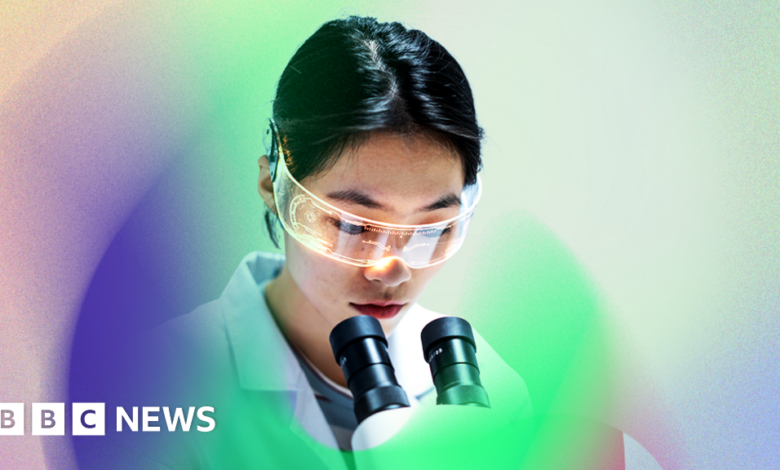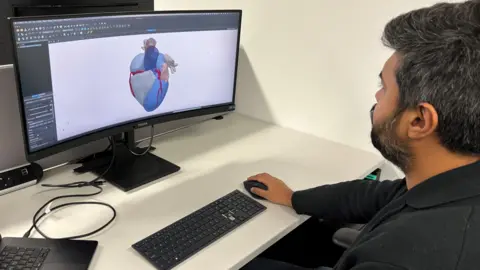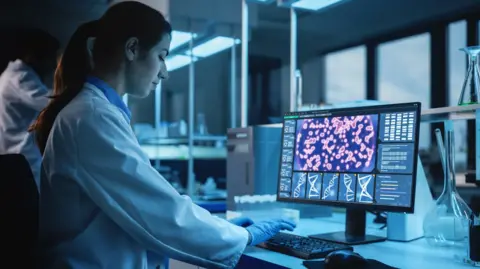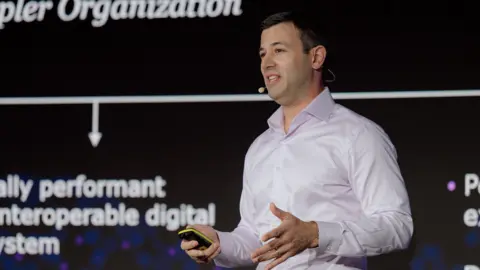Why ‘digital twins’ could speed up drug discovery

2024-12-13 03:08:26
 Adsilico
AdsilicoThis is the first of a six-part series on how AI is changing medical research and treatments.
The heart in front of me beats and moves like a human organ, but has no blood flowing through it, nor does it live in a human body.
It’s a computer-generated heart, or digital twin, used to test implantable cardiovascular devices, like stents, and prosthetic valves that, once confirmed they are safe, will eventually be used on real people.
But the heart’s creators, Adsilico, have gone beyond just creating one accurate model.
Using artificial intelligence and huge amounts of data, they have created multiple different hearts.
These AI-generated synthetic hearts can be made to reflect not just biological attributes like weight, age, gender and blood pressure, but health conditions and ethnic backgrounds.
As these differences often aren’t represented in clinical data, digital twin hearts can help device manufacturers conduct trials across more diverse populations than they could with human trials, or trials involving just digital twins without AI.
“This allows us to capture the full diversity of patient anatomies and physiological responses, which is not possible using conventional methods. This use of AI to enhance device testing leads to the development of devices that are more inclusive and safer,” says Adsilico chief executive Sheena Macpherson.
In 2018 an investigation by the International Consortium of Investigative Journalists revealed that 83,000 deaths and over 1.7 million injuries were caused by medical devices.
Ms Macpherson hopes that AI powered digital twins can cut down those numbers.
“To really make these devices safer, you need to test them more thoroughly, and it isn’t feasible to do that in a clinical trial environment due to the expense of it,” says Ms Macpherson, who is based in Northumberland.
“So you want to be able to use the computer-generated version, to make sure that whatever you’re doing, you’ve tested it as thoroughly as possible before you test it on a human.
“Even a fraction of those deaths – and the associated lawsuits – could have been avoided with more thorough testing. You can also get more detailed results.
“You could take the same [virtual] heart and you could test under low or high blood pressure, or against different disease progression, to see whether that affects the device in any way.”
Ms Macpherson adds: “[Virtual] testing gives medical device manufacturers many more insights. It also means that we can test in other sub patient groups, not just white men which clinical trials have traditionally been based on.”
 Getty Images
Getty ImagesAdsilico’s AI models are trained on a combination of cardiovascular data, and data from real MRI and CT scans, that includes medical imaging from consenting patients.
The data draws from detailed anatomical structures of the heart, to help create accurate digital representations of how medical devices will interact with different patient anatomies.
Adsilico’s trials involve the creation of a digital twin of the device to be tested, which is then inserted into the virtual heart in an AI-generated simulation.
It all takes place inside a computer, where the test can be replicated across thousands of other hearts – all AI-simulated versions of a real human heart. Human and animal trials, on the other hand, tend to involve just hundreds of participants.

Perhaps the biggest incentive for drug and device manufacturers to supplement clinical trials with AI digital twins is how it reduces the time it takes, which translates into big cost savings, too.
Drug manufacturer Sanofi, for example, hopes to reduce the testing period by 20%, while also increasing the success rate. It is using digital twin technology in its immunology, oncology and rare disease specialism.
Using biological data from real people, Sanofi creates AI-based simulated patients – not actual clones of specific individuals – that can be interspersed across the control and placebo groups within the trial.
Sanofi’s AI programmes also then creates computer-generated models of the drug to be tested, synthesising properties like how the drug would be absorbed across the body, so it can be tested on the AI patients. The programme predicts their reactions, too – replicating the real trial process.
 Sanofi
Sanofi“With a 90% failure rate across the industry of new drugs during clinical development, an increase of just 10% in our success rate by using technologies like digital twins could result in $100m in savings, given the high cost of running late phase clinical trials,” says Matt Truppo, Sanofi’s global head of research platforms and computational research and development.
The results so far have been promising, Mr Truppo, who is based in Boston, US, adds.
“There is still a lot to do. Many of the diseases we are now trying to impact are highly complex. This is where tools like AI come in. Powering the next generation of digital twins with accurate AI models of complex human biology is the next frontier.”
 PA Consulting
PA ConsultingDigital twins might have weaknesses though, says Charlie Paterson, an associate partner at PA Consulting and a former NHS service manager.
He points out that the twins are only as good as the data that they are trained on.
“[Due to] aged data collection methods, and low representation of marginalised populations, we could end up in a position where we could still be introducing some of those biases when we’re programming virtual recreations of individuals.”
Working with limited legacy data to train its AI is an issue Sanofi is aware of and working to resolve.
To fill gaps in its internal data sets – made up of millions of data points from the thousands of patients that undergo its trials each year – it sources data from third parties, like electronic health records and biobanks.
Back at Adsilico, Ms Macpherson is hopeful that one day AI digital twin technology will eliminate animal testing from clinical trials, which is still currently considered an essential part of the drug and device testing process.
“A virtual model of our hearts is still closer to a human heart than that of a dog, cow, sheep, or pig, which tends to be what they use for implantable device studies,” she says.





